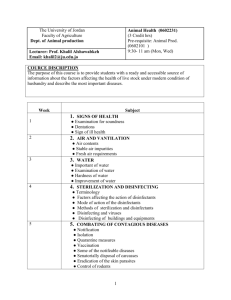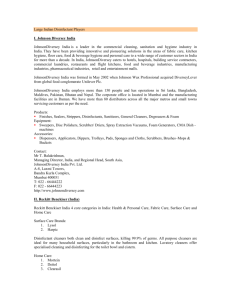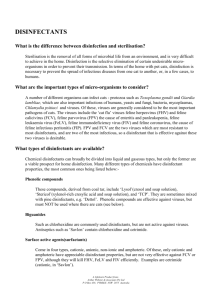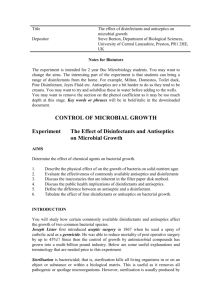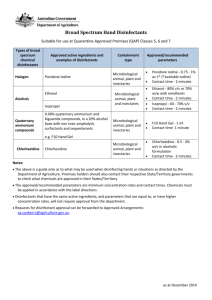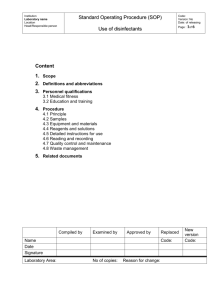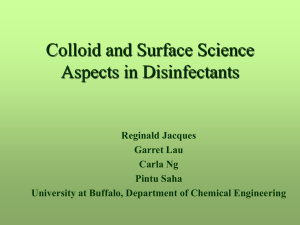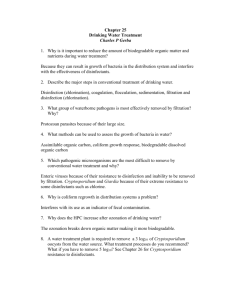10 disinfection_and_cleaning_tut_2012
advertisement
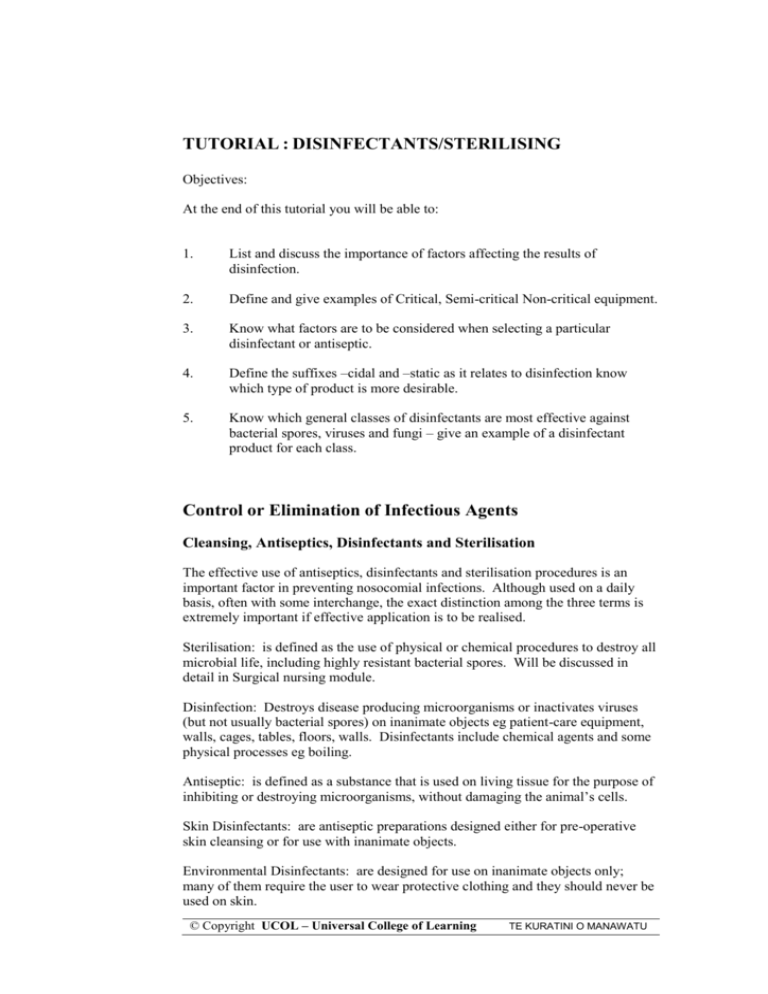
TUTORIAL : DISINFECTANTS/STERILISING Objectives: At the end of this tutorial you will be able to: 1. List and discuss the importance of factors affecting the results of disinfection. 2. Define and give examples of Critical, Semi-critical Non-critical equipment. 3. Know what factors are to be considered when selecting a particular disinfectant or antiseptic. 4. Define the suffixes –cidal and –static as it relates to disinfection know which type of product is more desirable. 5. Know which general classes of disinfectants are most effective against bacterial spores, viruses and fungi – give an example of a disinfectant product for each class. Control or Elimination of Infectious Agents Cleansing, Antiseptics, Disinfectants and Sterilisation The effective use of antiseptics, disinfectants and sterilisation procedures is an important factor in preventing nosocomial infections. Although used on a daily basis, often with some interchange, the exact distinction among the three terms is extremely important if effective application is to be realised. Sterilisation: is defined as the use of physical or chemical procedures to destroy all microbial life, including highly resistant bacterial spores. Will be discussed in detail in Surgical nursing module. Disinfection: Destroys disease producing microorganisms or inactivates viruses (but not usually bacterial spores) on inanimate objects eg patient-care equipment, walls, cages, tables, floors, walls. Disinfectants include chemical agents and some physical processes eg boiling. Antiseptic: is defined as a substance that is used on living tissue for the purpose of inhibiting or destroying microorganisms, without damaging the animal’s cells. Skin Disinfectants: are antiseptic preparations designed either for pre-operative skin cleansing or for use with inanimate objects. Environmental Disinfectants: are designed for use on inanimate objects only; many of them require the user to wear protective clothing and they should never be used on skin. © Copyright UCOL – Universal College of Learning TE KURATINI O MANAWATU Factors affecting the results of disinfection include: 1. Concentration of solution and duration of contact with the chemical. A weakened concentration or shortened exposure time may lessen effectiveness. 2. Amount of organic matter (soil, blood, faeces, pus, saliva, urine) present. Disinfectants can become inactivated unless organic matter is washed off first. 3. Surface areas to be disinfected eg porosity, cracks etc. Also, all dirty surfaces and areas must be fully exposed to disinfecting agents. 4. The material to be disinfected. 5. Ambient temperature. Disinfectants tend to work best at room temperature. 6. Presence of soap. Soap may cause certain disinfectants to be ineffective. Thorough rinsing of an object is necessary before disinfecting. 7. Nature and number of the contaminating microorganisms. Certain are killed more easily than others by disruption. The greater the number of pathogens on an object the longer the required disinfecting time. When selecting germicidal procedures, patient-care equipment can be classified as critical, semi-critical and non-critical. Critical: equipment includes those devices that are introduced directly into the body, such as surgical instruments, catheter and implants. Sterility is essential. Semi-Critical: equipment includes those items that come in contact with various mucous membranes. Although sterilisation is desirable, it is not essential. Disinfection of these items should inactivate vegetative bacterial cells and viruses. Examples of semi-critical equipment includes thermometers, speculums, endotracheal tubes, and otoscope heads, clipper blades and other diagnostic equipment eg endoscope, arthroscope etc. Non-critical: equipment includes environmental surfaces, such as cages, tables, floors, walks etc. These surfaces should be cleaned with detergent, rinsed well and chemically disinfected. © Copyright UCOL – Universal College of Learning TE KURATINI O MANAWATU Selecting Disinfectants and Antiseptics See table of commonly used disinfectants and antiseptics for main active ingredients and recommended uses. Detailed information regarding each product’s suitability in veterinary practice can be obtained by reading the manufacturer’s data sheets. Some of the main factors to consider when selecting a particular product include: 1. The intended use environmental eg kennels, cages, stalls, runs, equipment on living tissue eg skin, wounds 2. The product’s activity against specific microorganisms. 3. The contact time required. 4. Known local conditions eg water hardness. 5. Safety to animals and people. A product should be non-irritant, non-toxic and non-corrosive. Consult the manufacturers product details for recommended safety precautions eg protective clothing, ventilation. Some animal species are sensitive to some types of disinfectant (eg cats are sensitive to phenol; and formalin vapour irritates many animal’s eyes.) 6. Stability in storage 7. Odour. Preferably odourless or have a pleasant aroma. Strong odours or perfumes are offensive to some animals, promoting sneezing and irritation to the eyes. 8. Ease of use, eg should disperse readily in water if dilution is required. 9. Economy of use, eg cost per litre of diluted solution. 10. Effectiveness in the presence of organic matter. The presence of even relatively small amounts of organic material in water may render some disinfectants ineffective eg Savlon, Bleach. Effectiveness of Disinfectants against different microorganism Bacteria: The bactericidal capability of a disinfectant varies as some forms of bacteria are more resistant than others. The following list is in descending order of resistance of bacteria to disinfection: Bacterial spores (most resistant) Acid fast Bacteria eg Mycobacteria spp., Yersinia spp. Gram Negative Bacteria eg E.coli, Salmonella spp., Klebsiella spp. Gram Positive Bacteria eg Staphylococcus spp., Streptococcus spp. © Copyright UCOL – Universal College of Learning TE KURATINI O MANAWATU Disinfectants most effective against bacterial spores include: Aldehydes Ethylene Oxide Halogens (lesser extent) Disinfectants most effective against viruses include: Hypochlorites (eg Bleach) Glutaraldehyde (but slow acting) Ampholytic surfactants kill some viruses Many disinfectants are able to destroy fungal spores. Quaternary ammonium compounds and Pine oil fluid DO NOT KILL FUNGI! -cide (cidal) Indicates a product/chemical that kills particular type of microorganism eg, bacteriacide – kills bacteria; fungicide – kills fungi -stat (static) Indicates a product/chemical that prevents or inhibits the growth of a particular type of microorganism. It is best to choose a disinfectant that kills a microorganism rather then inhibits it’s growth. Chemical Disinfectants and Antiseptics Product Name Active Ingredients Presentation Uses/Comments Isopropyl alcohol Ethyl alcohol Methylated spirits Alcohol liquid Ethyl alcohol more effective than Isopropyl or Methyl for disinfection. General surface and skin disinfection. Moderately virucidal only in high concentration. Bleach (Halogen) hypochlorites Liquid Bactericidal and Virucidal; Highly effective, rapid acting but organic matters interferes, inexpensive, non-toxic. Environmental disinfectant, Do not splash on clothes. Cetavlon (Quaternary ammonium compound) Cetrimide Liquid Environmental use and skin disinfectant. Not very effective against many viruses; organic matter interferes. © Copyright UCOL – Universal College of Learning TE KURATINI O MANAWATU Halamid (Halogen) Sodium tosychloramide Powder Environmental use and skin, pre-injection, udder, hands. Jeyes Fluid (Phenol) Phenol compound Liquid Environment use ONLY; Rinse thoroughly; NOT FOR CAT HOUSING. Dettol (Phenol) Chloroxylenol Liquid Envrionmental use and skin disinfection. NOT FOR CAT HOUSING. Formula H Formaldehyde Liquid or Spray Environmental use only. Low power of penetration. Use for terminal disinfection; irrititating; hypersensitivity may result. Marinol Blue Roccal Benzalkonium Chloride Solution 10% or 50% Sol’n Pre-op instruments. Topically (skin diluted.) Parvocide (Glutaraldehyde Q.A.C) Aldehyde Liquid Broad spectrum disinfection for all animal contact surfaces. Environmental only. Detergent Iodophors Betadine Liquid Action based on slow release of iodine and detergent action. Less affected by organic matter than bleach. Stains some surfaces. Expensive. Environmental and skin disinfection. Vet-cide Tri-n-butyltinbenzoate Liquid Environmental use only. Powder Environmental use only. Formaldehyde Isopropyl alcohol Virkon (Perioxide) Oxidising agents Hibicet Cetrimide Liquid Chlorhexidine gluconate Isopropyl alcohol © Copyright UCOL – Universal College of Learning Environmental and skin disinfectant. TE KURATINI O MANAWATU Trigene halogenated tertiary Amine, biguanide liquid and spray Hydrochloride Benzyl ammonium chloride Dodecylamine sulphate general purpose food prep and high level disinfection of surfaces Common Antiseptics Product Name Active Ingredient Presentation Uses/Comments Hibiscrub vet Chlorhexidine gluconate Solution Rapid bactericidal skin cleanser and surgical scrub. Ototoxic and corneal irritant Nolvasan Surgical Chlorhexidine Acetate Solution Skin and wound cleanser. Ototoxic and corneal irritant Povidine Antiseptic Solution Povidine-iodine Solution Topical application Burns/Wounds etc Savlon Vet Concentrate Chlorhexidine gluconate Cetrimide Solution Wounds(dilute); pre-op Precautions and use of Chemical Disinfectants When using any chemical, including disinfectants and cleaning materials, care should be taken to ensure their correct handling: - Store in the original containers with the lids secured Keep away from animals and children Wear protective clothing when recommended; always avoid contact with the skin ONLY use disinfectants for the purpose recommended by the manufacturer Use the correct concentration for the surface to be disinfected Wash hands thoroughly after use, especially eating or drinking. Some general rules apply to the use of disinfectants: - Use the correct dilution. Too weak = ineffective; Too strong = wasteful but also can lead to irritation of animal skin, eyes, feet, respiration. Inadequate rinsing can cause similar problems. © Copyright UCOL – Universal College of Learning TE KURATINI O MANAWATU - Use water only to dilute disinfectants. It is potentially dangerous to mix disinfectants (noxious gases or corrosive action) unless recommended by the manufacturer. - Use at the chemical’s optimum temperature for action. Many disinfectants are more effective when used with hot water than with cold. With others this is not an issue. - Ensure appropriate contact time is allowed. All disinfectants require TIME to kill or inactivate microorganisms and are ineffective if rinsed off too soon after application. Contact time will vary with the type of disinfectant and the organism to be killed. Consult manufacturers instructions. - USE FRESHLY MADE UP SOLUTIONS. Many disinfectants begin to deteriorate when mixed with water. - Equipment and receptacles used with disinfectants should be thoroughly clean and rinsed before use. Organic matter reduces or inactivates many disinfectants. - All disinfectants should be thoroughly rinsed off once the contact time is completed, unless otherwise recommended. - Always adhere to precautions recommended by the manufacturer. Commonly used disinfectants 1. Virkon (sodium peroxomonosulphate, sodium dodecylbenzene sulphonate, sulfamic acid): mix at 1:50 dilution for activity against parvovirus and 1:100 against other micro-organisms ie. Bacteria, fungi, mycoplasmas and moulds. This is a one-step disinfectant for all surfaces and equipment. 2. Sodium hypochlorite (Bleach). 0.175% will kill viruses as well as bacteria and fungi(ringworm) the activity is inhibited by the presence of organic material so thorough cleaning is importat and even then bleach is often used at double strength 0.25%. Ensure the stronger concentration is used for cleaning after parvovirus cases. 3. Spray–n-wipe /Exit mould (sodium hypochlorite) are other commercial cleaners that can be used for bench tops routinely. For infectious cases, Virkon can be used safely afterwards. 4. Savlon can be used for the environment and skin disinfection. Diluted 1:20. Not so effective for fungi, so inadequate if ringworm is suspected 5. Dettol can be used for skin and the environment. But because of the danger of cat respiratory reactions not commonly used in veterinary situations 6. Trigene for general disinfection of unsoiled surfaces, dilute Trigene Advance 1:200. In the presence of organic matter , after cleaning use 1:100 dilution. Rinse and dry before use © Copyright UCOL – Universal College of Learning TE KURATINI O MANAWATU DISINFECTANT AND ANTISEPTIC TUTORIAL 1. Examine the products commonly available in veterinary clinics. For those products complete the chart: Active Recommended contraindications ingredient use Virkon Trigene Hibicet Bleach Dettol Biocil scrub(detergent iodophor) 2. Show the calculations to make up: 300mL of 1% Virkon (Virkon is supplied as a powder) 5 litres of 0.25% bleach. (Janola is supplied as 42g/L) 3. Which products are suitable for disinfecting plastic otoscope cones and clipper blades to ensure there is no transmission of fungi/yeast infection. (What strength?) © Copyright UCOL – Universal College of Learning TE KURATINI O MANAWATU 4. Which product can be used for disinfecting the stones in aquariums? 5. Which products can be used in the presence of organic matter? Which cannot? Trigene Virkon Janola Povidine iodine Hibiclens 6. Which products have residual activity? Trigene Virkon Janola Povidine iodine Hibiclens 7. which may be used as antiseptics? Trigene Virkon Janola Povidine iodine Hibiclens 8. When should a solution of Virkon be changed? 9. When should a solution of Hibitane used to disinfect thermometers be changed © Copyright UCOL – Universal College of Learning TE KURATINI O MANAWATU
